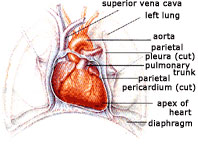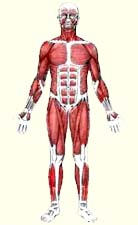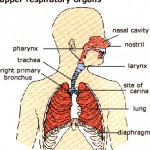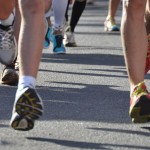Heart and lung function The human body is built for physical activity,not for rest. Man through the ages man has used his muscles to survive during his working  hours, as well as leisure time, demanding physical effort. Today we live a more sedentary life. The human heart at rest pumps out 7-9pt (4-5l) per min of blood, with physical effort the volume might rise to 18-70pt (10-40l) per min. When breathing normally at rest 6 l per min of air is exchanged, but the volume can increase to 100 l per min if necessary, and a well-conditioned athlete can exchange up to 200 l per min.
hours, as well as leisure time, demanding physical effort. Today we live a more sedentary life. The human heart at rest pumps out 7-9pt (4-5l) per min of blood, with physical effort the volume might rise to 18-70pt (10-40l) per min. When breathing normally at rest 6 l per min of air is exchanged, but the volume can increase to 100 l per min if necessary, and a well-conditioned athlete can exchange up to 200 l per min.
There is little risk of sporting activity leading to serious medical complications. This likelihood varies, however, with the age and physical condition of the athlete and with the individuals training methods (some training methods of beginners as well as those “in the know” can be rather foolhardy taking into account the unnecessary stresses they can put the untrained body under; for e.g.: running a marathon without the right fitness levels). Some athletes “in the know” can be the most dangerous as they like to think their body likes (sic) the stresses of running on memory (the memory being, of when their body was well-conditioned through training in the past). Factors which increase the risk of suffering a heart attack (myocardial infarction) are above all thought to be smoking and high blood pressure. Anyone who is fifty years old, has high blood pressure and is a very heavy smoker (more than 25 cigarettes a day) run a 100 per cent greater risk of suffering a heart attack than a non-smoker of the same age with normal blood pressure. It must also be understood, however that if a person is suffering from heart disease without it being detected the chances of a fatal heart attack occurring during exercise are high.
Yet again, another excellent reason why one should consult a sports doctor before beginning an exercise routine.
It is impossible to say with certainty whether any of the positive effects of a physically active life (for example, improved cardiovascular performance and metabolism) provide protection against cardiovascular and other diseases. There are several studies, however, which show that the incidence of heart disease and subsequent death is lower among the physical active than among the inactive. Exactly how great an effect physical activity has cannot be calculated, but, along with other aspects of the individual’s lifestyle, it is probably significant. Frequency of exercise is important, and it has been shown that regular physical activity reduces the amount by which blood pressure rises for a specified expenditure of effort. The percentage of some blood fats (which may influence the development of heart attacks) can also be reduced by training twice to three times a week.
Available evidence indicates that even very moderate physical activity, provided it is regular, is valuable in preventing cardiovascular disease.
Sudden death Occasionally cases of sudden death during sports activity are reported . A number of factors are probably relevant. Studies have shown, for e.g., that the number of sudden deaths increase in cold weather, a cold shower or a cold bath may cause a severe rise of blood pressure which can have disastrous effects on untrained people. Hard physical work in hot weather can result in huge losses of body fluid and thereby increase the risk that the circulation and sweating system will not be able to cope with the stress placed upon them.
Medical factors that should be considered in this connection are chest pains (regardless of type), a previous heart attack, irregular heart beat, disorder of the heart valves, inflammation of cardiac muscle and high blood pressure. All may constitute risk factors as do smoking and consumption of alcohol. A number of cases of sudden death have also been described in connection with doping.
Pains in the chest and abnormal fatigue during sporting activity are serious warning signals. If they appear, the sporting activity should be ceased immediately.
Athletic competitions should never be run in very hot or very cold weather. Competitors should always be given the chance to warm-up effectively in cold weather. Training should be carried out regularly, the distance and intensity of training being increased gradually.
High blood pressure anyone suffering from high blood pressure (hypertension) should only take part in sport after consultation with a medical doctor. In general,  however, some forms of high blood pressure benefit from physical activity.
however, some forms of high blood pressure benefit from physical activity.
Physical check-up If sporting activity is taken up after the age of forty or if physical activity produces symptoms such as abnormal fatigue, obvious breathlessness or irregular heart beat, a doctor should be consulted. Even if irregularities are present, they do not necessarily preclude sensible sporting activities. It is worth noting that even after the most careful examination, a doctor cannot always predict a potential cardiovascular disorder of sudden onset.
Studies have shown that people who do not smoke, drink little alcohol, take food and exercise regularly and are of normal weight, live longer on average than people with less healthy habits. Everyday habits are more important than medical measures when it comes to preventing illness and death.
View the further articles under the Sports Doctor section:
[catlist argument1=value1 argument2=value2]
























